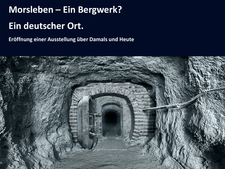Morsleben – A mine? A German place
Exhibition at the Morsleben nuclear repository opened
- The Morsleben repository for radioactive waste has a colourful history: Potash and rock salt mining, armaments production during the Nazi era, livestock farming and toxic-waste dump in the GDR and, since 1979, radioactive waste repository.
- The historical reappraisal has led to a new permanent exhibition narrating and analysing the comprehensive development of the facility as a whole to date. The presentation was designed and drawn up with the assistance of an expert advisory board.
- The exhibition can be visited permanently from 26 January 2016 at the Morsleben information centre.

![]() Insight into the colourful history of the Morsleben repository
Insight into the colourful history of the Morsleben repository
For the first time, a comprehensive permanent exhibition is readily available to interested citizens, where they can get a glimpse at the eventful history of the Morsleben mine.
Wolfram König, the BfS president, and Roland Jahn, the Federal Commissioner for the Records of the State Security Service of the former GDR (BStU), opened the exhibition on the mine's over-hundred-year-old history at the BfS information centre at the Morsleben repository.
The history of Morsleben
Since the German unification, the Morsleben repository for radioactive waste has been operated by the BfS. It has a colourful history: Potash and rock salt mining, armaments production during the Nazi era, livestock farming and toxic-waste dump in the GDR and, since 1979, radioactive waste repository.
"Like under a burning glass, the various stages of the Morsleben history reflect German history of the past 100 years. Forced labour underground and the location near the border between the two German states later on led to the fact that hiding, repressing and concealing things were made a general principle,"
BfS president König said. "We need to face this weight of the past. Safe radioactive waste disposal lives by the exact opposite: Transparency and traceability are key prerequisites for confidence in government measures. This standard is also set for the pending plan-approval procedure for the decommissioning of the facility."
Reappraisal of this history
The historical reappraisal has led to a new permanent exhibition narrating and analysing the comprehensive development of the facility as a whole to date. The presentation was designed and drawn up with the assistance of an expert advisory board.
At the exhibition opening, Roland Jahn from the BStU said: "The exhibition is an impressive compilation of the history of this place, where Nazi dictatorship and SED – German Socialist Unity Party – have left their marks. It calls for reflection on government measures and information policy. Not least the Stasi secret police documents contribute today to making the cover-up policy of the SED – German Social Unity Party – transparent in terms of the nuclear waste repository and thus to encourage the questioning of government information."
The exhibition can be visited permanently from 26 January 2016 at the Morsleben information centre.
Address
Amalienweg 1
39343 Ingersleben OT Morsleben
Office hours
Monday to Thursday 9 a.m. to 3 p.m.
Friday from 9 a.m. to 2 p.m.
State of 2016.01.25

